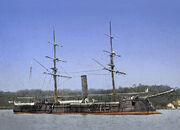
A rare photo indeed, this is a color photo of Stonewall as she was when serving in the Japanese Fleet as "Azuma." It is widely believed her paint job in Japanese service was essentially the same as it had been when under Confederate control.
CSS STONEWALL (1864)
Built: Bordeaux, France
Commissioned: January, 1865
Service: Atlantic Ocean
Home Port: None
Dimensions: 186'9" Length, 32'6" Beam, 14'3" Draft
Armor: At least 4" iron, wood backed (may have been greater)
Armament: 2x6.4" Armstrong Rifles in non-rotating Turret; 1x11" (100lb Armstrong)
Engines: Twin Screw
Speed: 10 Knots
Crew: 135
Fate: Surrendered to Spanish Authorities, May 1865. Then handed over to the US. Briefly under the stewardship of the US Government, which laid her up and subsequently sold her to the Japanese Shogunate in 1867. The ship was seized from the Shogun and used by Imperial Forces in the Japanese Civil War. Served IJN until 1888; later disposed of at an uncertain date.
Summary
Named for Stonewall Jackson, CSS Stonewall was the only foreign built ironclad purchased by the Confederacy to actually see service with the CSN. Built between 1863 and 1864 in France, various diplomatic tactics were used to conceal the true intentions of the builder. When it became clear that the vessel was going to be sold to the Confederacy, the French attempted to seize her from her builder; the builder then circumvented the law by "selling" her to Denmark, which consequently transferred her to a Confederate crew at Copenhaagen.
Stonewall had a unique design, as, in addition to her foreign origins, she was the only turreted warship to be completed for the Confederacy. In addition to carrying a massive 100lb Armstrong Rifle in her bow, mounted on a three point pivot, she carried a pair of deadly accurate 6.4" Armstrong Rifles in a rear, non-rotating turret, which could be turned on a pivoting mount to fire in either broadside; this was an arrangement similar to that of the turret mounted guns carried by USS Keokuk .
After taking on badly supplies for the Confederacy in France, Stonewall set sail to Spain, and was delayed by a storm. Her captain took the opportunity to take on high quality coal at Ferrol, Spain. There, she prepared for orders she had received at some point during her fitting out cruise - an ambitious plan to act as a high speed armored commerce raider. The plan involved reducing the blockade off Wilmington, disrupting trade with California, attacking New England coastal cities, and even raiding Union fishing fleets off the Newfoundland banks. All of these orders were very much within her capabilities - she was perhaps the most heavily armored warship constructed for the CSN (reports that the armor was 'merely' 4 inches of iron with wood backing probably refer to her most lightly protected areas, and even then, these were rolled steel plate rather than laminate), and her guns were capable of sinking virtually any oceanic vessel of the United States Navy. In addition she was fast, maneuverable, and specifically equipped for handling both wooden vessels and the much hated monitors in service with the USN at the time. One post war source, when she was being viewed with fascination by the public after being acquired by the US Government, even calls her a "monitor killer."
When taking on her last set of provisions in Ferrol, Stonewall was tracked and watched by two US Frigates - USS Niagara and USS Sacramento , which sat just outside Spanish territorial waters attempting to force her crew to surrender without firing a shot. However, the Spanish government refused to intern the vessel, and instead, the ship stunned the two Union vessels by appearing just off the coast and offering battle. Knowing themselves to be poorly protected and outgunned, they refused battle and gave her a wide berth.
No further incidents occurred until she arrived at Havana, Cuba, in May, 1865 where the crew learned that the war had officially ended. Stonewall's captain turned the vessel over to the Governor-General of Cuba, both on principal of refusing to surrender her to the Yankees, and because the Cubans had offered to pay off crew and settle outstanding debts. Upon her surrender, she was briefly interned, then handed over to the US Government, which treated her as a war prize.
Stonewall was laid up for two years as Washington attempted to decide what to do with her. Over the protests of some US Navy officers who had hoped she would be commissioned for USN service, she was instead sold to the Tokugawa Shogunate in Japan, with the intent of using her to support the Shogun's cause in the developing Japanese Civil War. The ship was seized upon her arrival in Japan by Imperial forces, renamed Kotetsu, and used prominently in a number of battles with Shogunate forces. Following the final victory of the Meiji Emperor, she was renamed Azuma, and continued to serve the IJN until around 1887, when she was converted to a receiving/accomodation hulk. At some point thereafter, she was stricken from the record and scrapped. The design of the Stonewall heavily influenced the design of Japan's first indigenous modern warships.